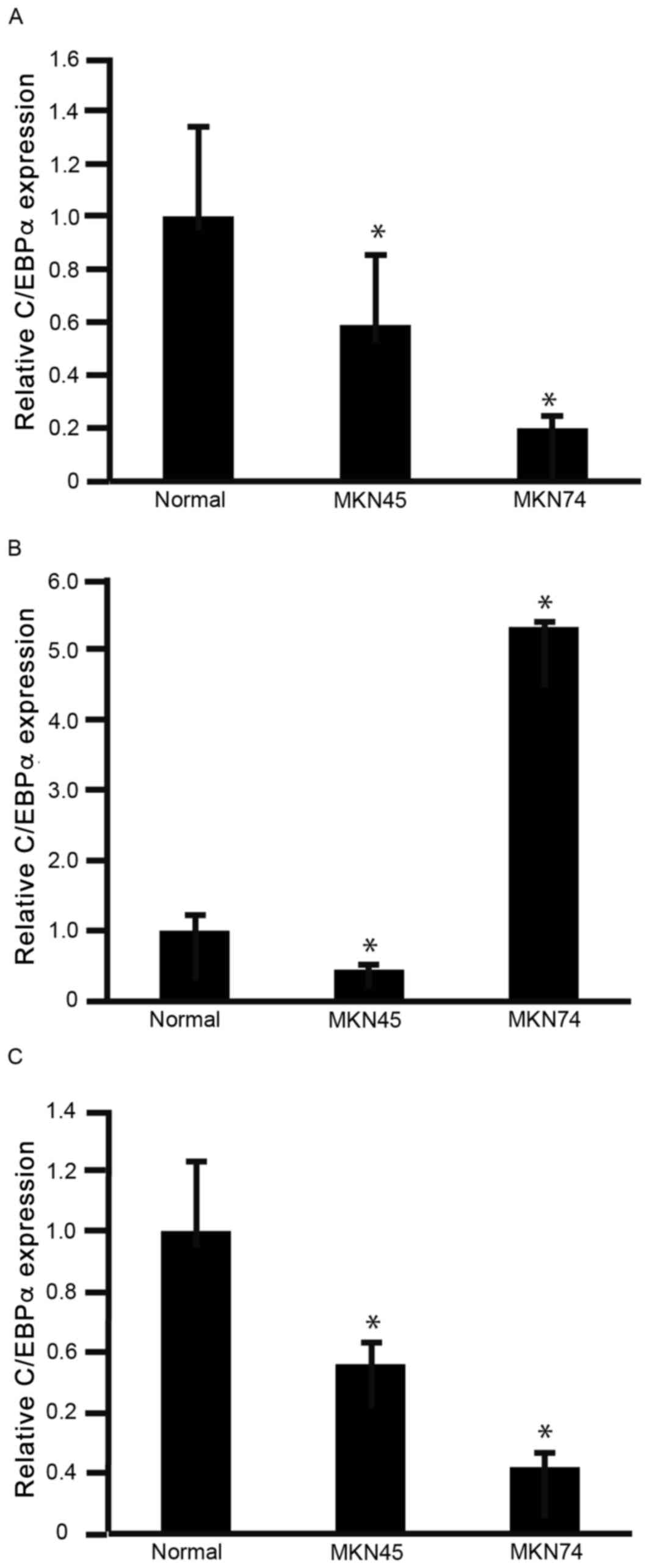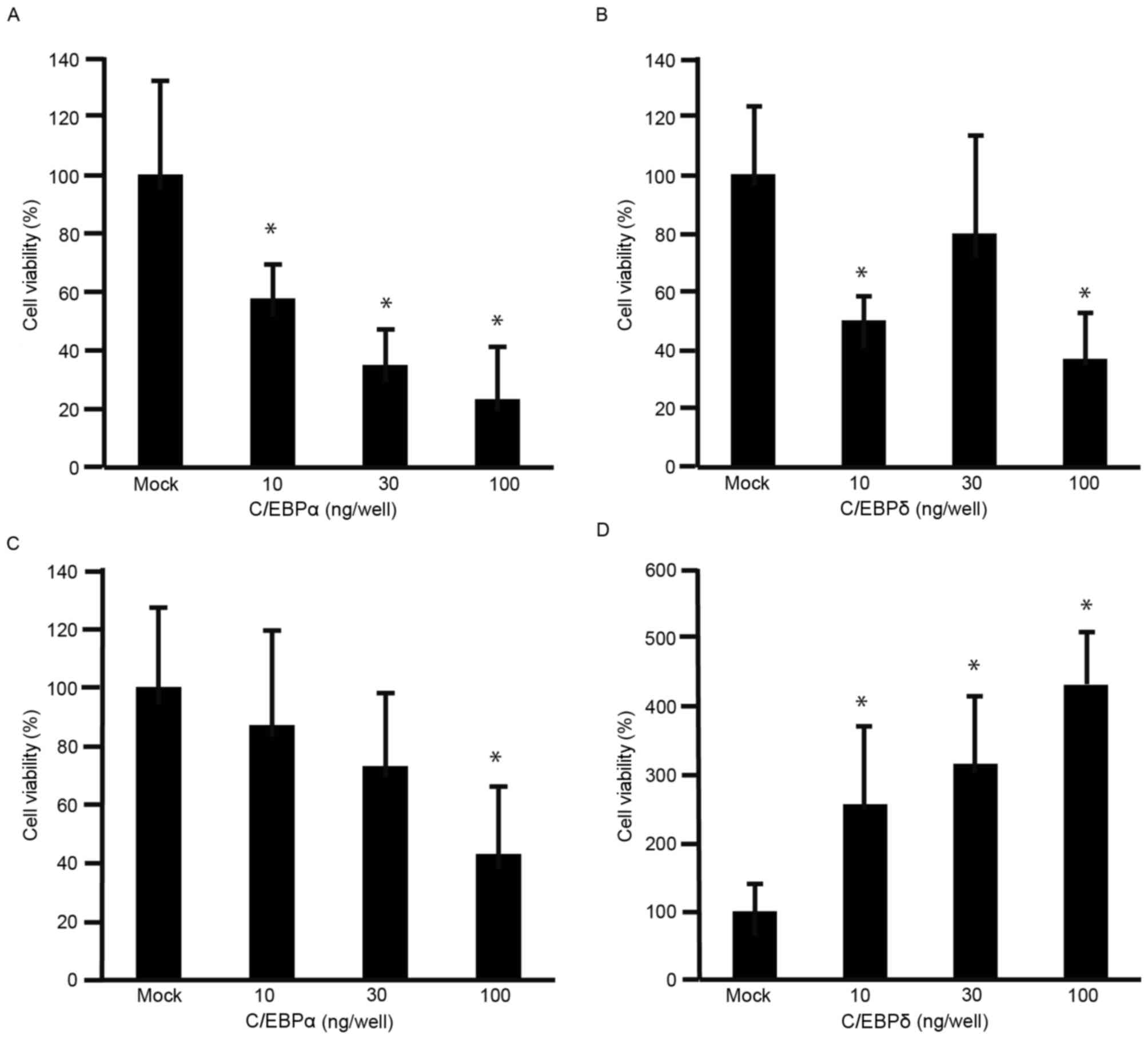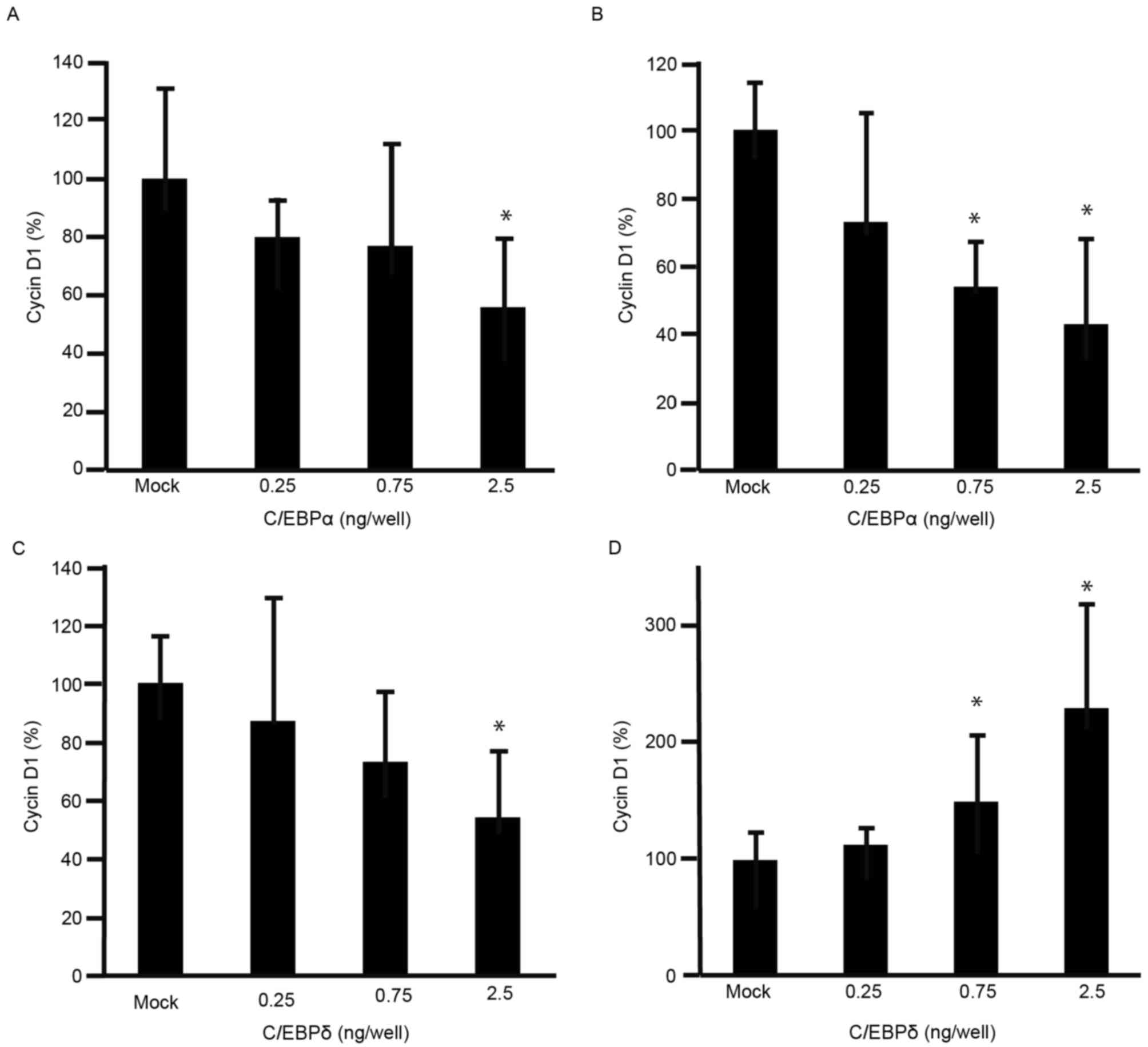CCAAT/enhancer-binding protein α decreases the viability of gastric cancer cells
- Authors:
- Published online on: April 5, 2017 https://doi.org/10.3892/ol.2017.5987
- Pages: 4322-4326
Abstract
Introduction
Gastric cancer (GC) is a leading cause of cancer-related mortality globally (1). Prognosis is poor in patients with advanced GC (2). Endoscopic surgical resection is currently used for the treatment of early-stage GC only (3). The lack of non-surgical alternatives in treatment approaches has resulted in a requirement to develop novel and targeted therapies to treat GC.
CCAAT/enhancer-binding proteins (C/EBPs) are transcription factors that belong to the family of basic leucine zipper proteins, and regulate gene expression in cell viability and inflammation (4,5). C/EBPα, C/EBPβ and C/EBPδ are involved in terminal differentiation of cells and inflammatory processes (6–8). Furthermore, the expression levels of C/EBPα and C/EBPβ are altered in cancerous tissue compared with in surrounding healthy tissues (9). Although it has been demonstrated previously that C/EBPδ is involved in GC (10), its specific role remains unknown. The specific roles of C/EBPα, C/EBPβ and C/EBPδ in GC remain incompletely understood.
Therefore, the expression levels of C/EBPα, C/EBPβ and C/EBPδ were investigated in GC cells as a potential treatment method to decrease the viability of GC cells. Experiments were conducted using the Epstein-Barr virus (EBV) episomal vector. EBV episomal vector containing the latent origin of replication, oriP, and nuclear antigen are able to efficiently transfect host cells, and stably express and amplify genes of interest in daughter cells following division (11).
Materials and methods
Cell culture
The GC cell lines MKN45 and MKN74 were purchased from RIKEN BioResource Center Cell Bank (Tsukuba, Japan). Cells were cultured in 10 cm dishes (Asahi Techno Glass Corporation, Funabashi, Japan) in RPMI-1640 medium (Sigma; Merck KGaA, Darmstadt, Germany) supplemented with 10% fetal bovine serum (FBS; Thermo Fisher Scientific, Inc., Waltham, MA, USA) at 37°C, in a humidified chamber containing 5% CO2.
Plasmid construction and transfection
A C/EBPα fragment, digested with NruI-EcoRV from pG28B5.0 plasmid (kindly provided by Dr Kleanthis G. Xanthopoulos, IRRAS AB, Stockholm, Sweden), was subcloned into EcoRV sites of the episomal vector pEBMulti-Neo (Wako Pure Chemical Industries, Ltd., Osaka, Japan) to generate pEB/C/EBPα-Neo (12). A C/EBPδ fragment digested with EcoRI from IRCB003O22 (RIKEN BioResource Center DNA Bank, Tsukuba, Japan) was subcloned into pBluescript2SK(−) (Agilent Technologies, Inc., Santa Clara, CA, USA) to construct pBlue/C/EBPδ. An EcoRV-BamHI-digested fragment of pBlue/C/EBPδ was subcloned into the EcoRV-BamHI site of pEBMulti-Neo to generate pEB/C/EBPδ-Neo. Episomal plasmid vector constructs were transfected into GC cells and normal gastric mucosa cells. pEB/C/EBPα-Neo and pEB/C/EBPδ-Neo were transfected using Lipofectamine® LTX (Thermo Fisher Scientific, Inc.) into the cell cultures at concentrations of 10 or 100 ng/well in 96-well plates and at 2 µg/well in 6-well plates, according to the manufacturer's protocol. Mock transfection was carried out without nucleic acid material.
Cell viability analysis
Cells were trypsinized, harvested, centrifuged at 100 × g for 3 min at 4°C and seeded in 96-well flat-bottom plates (Asahi Techno Glass Corporation) at a density of 1,000 cells/well, and incubated for 24 h in Dulbecco's modified Eagle's medium (Sigma; Merck KGaA) supplemented with 10% FBS. Following incubation for 24 h, the cells were transfected with pEB/C/EBPα-Neo or pEB/C/EBPδ-Neo. Following incubation for 72 h, cell viability was analyzed using a 3-(4,5-dimethylthiazol-2-yl)-5-(3-carboxymethoxyphenyl)-2-(4-sulfophenyl)-2H-tetrazolium inner salt (MTS) assay (Promega Corporation, Madison, WI, USA), according to the manufacturer's protocol. MTS is bioreduced by viable cells into a colored formazan product with an absorbance at 490 nm. Absorbance at 490 nm was analyzed using an iMark Microplate Absorbance Reader (Bio-Rad Laboratories, Inc., Hercules, CA, USA). Mock-transfected cells were used as a control.
Reverse transcription-quantitative polymerase chain reaction (RT-qPCR)
GC and normal gastric mucosa cells were cultured in 6-well plates (Asahi Techno Glass Corporation). When the cells reached 70% confluence, they were transfected with 0, 0.25, 0.75 or 2.5 mg pEB/C/EBPα-Neo or pEB/C/EBPδ-Neo. Total RNA was isolated using Isogen (Nippon Gene Co., Ltd., Tokyo, Japan) and 5 µg RNA was used for first-strand cDNA synthesis, using the SuperScript III First-Strand Synthesis system (Thermo Fisher Scientific, Inc.), according to the manufacturer's protocol. qPCR was performed using Fast SYBR Green Master Mix (Thermo Fisher Scientific, Inc.) for 40 cycles with 5 sec of denaturation at 95°C and 5 sec of annealing/extension at 60°C. PCR primers and amplicon lengths for qPCR are presented in Table I. Ribosomal protein L19 (RPL19), a constitutively expressed housekeeping gene (13), was used as an endogenous control to monitor the amount of mRNA. The gene expression levels were automatically analyzed using the MiniOpticon system (Bio-Rad Laboratories, Inc.), based on the ΔΔCq method (14). The relative expression levels were calculated as the expression level of a specific gene divided by that of RPL19. Human whole stomach RNA was purchased from Clontech Laboratories, Inc. (Mountain View, CA, USA) and used as a healthy control.
Statistical analysis
One-way analysis of variance was calculated using JMP software (version 10.0.2; SAS Institute, Cary, NC, USA) to evaluate statistical significance. P<0.05 was considered to indicate a statistically significant difference.
Results
To determine the expression levels of C/EBPα (Fig. 1A), C/EBPβ (Fig. 1B) and C/EBPδ (Fig. 1C) in GC cells, RNA was isolated from MKN45 and MKN74 cells for analysis using RT-qPCR. The expression levels of C/EBPα and C/EBPδ were significantly decreased in MKN45 and MKN74 cells, compared with normal stomach (gastric) mucosa (P<0.05; Fig. 1A and C). The expression levels of C/EBPβ were significantly decreased in MKN45 cells, but significantly increased in MKN74 cells, compared with normal stomach mucosa (P<0.05; Fig. 1B). These results indicated that C/EBPα and C/EBPδ warranted further investigation for their potential involvement in decreasing GC cell viability. However, the biological significance of C/EBPβ in GC cells was not clear from these results.
The viability of MKN45 cells was decreased by C/EBPα (Fig. 2A) and C/EBPδ (Fig. 2B), compared with that of mock-transfected cells (P<0.05). Although the viability of MKN74 cells was significantly decreased by C/EBPα at 100 ng/well (P<0.05; Fig. 2C), it was significantly increased by C/EBPδ (P<0.05; Fig. 2D). These results indicated that C/EBPα decreased the viability of GC cells. To further understand the effects of C/EBPα and C/EBPδ on cell viability, expression levels of cyclin D1 were analyzed using RT-qPCR. The expression levels of cyclin D1 were decreased in MKN45 and MKN74 cells transfected with C/EBPα (Fig. 3A and B). The expression levels of cyclin D1 were decreased in MKN45 cells transfected with C/EBPδ (Fig. 3C), but increased in MKN74 cells transfected with C/EBPδ (Fig. 3D).
Discussion
C/EBPα is expressed in normal gastric epithelium and downregulated in GC (15). Previous studies have also demonstrated that C/EBPα decreased the viability of hepatocellular carcinoma cells (16,17). In the present study, the expression levels of C/EBPα were identified to be decreased in GC cells. The results indicated that C/EBPα is able to facilitate tumor cell suppression in GC. C/EBPα was able to decrease metastasis of GC by upregulating microRNA-100 (18). The results of the present study indicated that expressing C/EBPα is potentially useful in the targeted treatment of GC.
Previous studies have demonstrated that, during inflammation, C/EBPδ is recruited to the promoter region of cyclooxygenase-2, although its expression levels remained constant (19). Currently, to the best of our knowledge, no conclusive study of the expression levels of C/EBPδ in GC cells has been performed. In liver cancer, C/EBPδ acts as a tumor suppressor (20). In the present study, C/EBPδ was downregulated in GC cells, indicating that C/EBPδ acted as a tumor suppressor. However, C/EBPδ decreased the viability of MKN45 cells, but increased the viability of MKN74 cells. These results indicated that C/EBPδ may serve an ambiguous role as a tumor suppressor or promoter, but it was not possible to determine this conclusively. Further studies may assist in our understanding of the functional role of C/EBPδ in GC. In the present study, the expression levels of C/EBPβ were decreased in MKN45 cells. It was assumed that not all GC cells exhibited increased expression of C/EBPβ; however, it was not possible to determine the percentage of GC cells that did. The expression level of C/EBPβ in GC is generally increased compared with that in healthy gastric epithelium (21). In further studies, immunohistological and flow cytometric analysis of cell cycle should be performed to improve our understanding of the expression of C/EBPα, C/EBPβ and C/EBPδ.
The expression levels of C/EBPα and C/EBPδ were decreased in GC cells compared with in healthy gastric epithelium. Expression of C/EBPα decreased the viability of GC cells, and, therefore, C/EBPα may potentially be used in novel GC therapies.
Acknowledgements
The present study was supported by a Grant-in-Aid for Scientific Research (C) from the Japan Society for the Promotion of Science (grant no. 15K09032).
References
|
Jemal A, Bray F, Center MM, Ferlay J, Ward E and Forman D: Global cancer statistics. CA Cancer J Clin. 61:69–90. 2011. View Article : Google Scholar : PubMed/NCBI | |
|
de Vita F, Di Martino N, Fabozzi A, Laterza MM, Ventriglia J, Savastano B, Petrillo A, Gambardella V, Sforza V, Marano L, et al: Clinical management of advanced gastric cancer: The role of new molecular drugs. World J Gastroenterol. 20:14537–14558. 2014. View Article : Google Scholar : PubMed/NCBI | |
|
Kim MY, Cho JH and Cho JY: Ever-changing endoscopic treatment for early gastric cancer: Yesterday-today-tomorrow. World J Gastroenterol. 20:13273–13283. 2014. View Article : Google Scholar : PubMed/NCBI | |
|
Tsukada J, Yoshida Y, Kominato Y and Auron PE: The CCAAT/enhancer (C/EBP) family of basic-leucine zipper (bZIP) transcription factors is a multifaceted highly-regulated system for gene regulation. Cytokine. 54:6–19. 2011. View Article : Google Scholar : PubMed/NCBI | |
|
Kheolamai P and Dickson AJ: Liver-enriched transcription factors are critical for the expression of hepatocyte marker genes in mES-derived hepatocyte-lineage cells. BMC Mol Biol. 10:352009. View Article : Google Scholar : PubMed/NCBI | |
|
Tomizawa M, Garfield S, Factor V and Xanthopoulos KG: Hepatocytes deficient in CCAAT/enhancer binding protein alpha (C/EBP alpha) exhibit both hepatocyte and biliary epithelial cell character. Biochem Biophys Res Commun. 249:1–5. 1998. View Article : Google Scholar : PubMed/NCBI | |
|
Yamasaki H, Sada A, Iwata T, Niwa T, Tomizawa M, Xanthopoulos KG, Koike T and Shiojiri N: Suppression of C/EBPalpha expression in periportal hepatoblasts may stimulate biliary cell differentiation through increased Hnf6 and Hnf1b expression. Development. 133:4233–4243. 2006. View Article : Google Scholar : PubMed/NCBI | |
|
Akira S, Isshiki H, Sugita T, Tanabe O, Kinoshita S, Nishio Y, Nakajima T, Hirano T and Kishimoto T: A nuclear factor for IL-6 expression (NF-IL6) is a member of a C/EBP family. EMBO J. 9:1897–1906. 1990.PubMed/NCBI | |
|
Tomizawa M, Horie H, Yamamoto H, Matsunaga T, Sasaki F, Hashizume K, Hiyama E, Kaneko M, Suita S, Ando H, et al: Reciprocal expression of CCAAT/enhancer binding proteins α and β in hepatoblastomas and its prognostic significance. Oncol Rep. 17:341–344. 2007.PubMed/NCBI | |
|
Balamurugan K and Sterneck E: The many faces of C/EBPδ and their relevance for inflammation and cancer. Int J Biol Sci. 9:917–933. 2013. View Article : Google Scholar : PubMed/NCBI | |
|
Yates JL, Warren N and Sugden B: Stable replication of plasmids derived from Epstein-Barr virus in various mammalian cells. Nature. 313:812–815. 1985. View Article : Google Scholar : PubMed/NCBI | |
|
Antonson P and Xanthopoulos KG: Molecular cloning, sequence, and expression patterns of the human gene encoding CCAAT/enhancer binding protein alpha (C/EBP alpha). Biochem Biophys Res Commun. 215:106–113. 1995. View Article : Google Scholar : PubMed/NCBI | |
|
Davies B and Fried M: The L19 ribosomal protein gene (RPL19): Gene organization, chromosomal mapping, and novel promoter region. Genomics. 25:372–380. 1995. View Article : Google Scholar : PubMed/NCBI | |
|
Tam S, Clavijo A, Engelhard EK and Thurmond MC: Fluorescence-based multiplex real-time RT-PCR arrays for the detection and serotype determination of foot-and-mouth disease virus. J Virol Methods. 161:183–191. 2009. View Article : Google Scholar : PubMed/NCBI | |
|
Regalo G, Resende C, Wen X, Gomes B, Durães C, Seruca R, Carneiro F and Machado JC: C/EBP alpha expression is associated with homeostasis of the gastric epithelium and with gastric carcinogenesis. Lab Invest. 90:1132–1139. 2010. View Article : Google Scholar : PubMed/NCBI | |
|
Tomizawa M, Wang YQ, Ebara M, Saisho H, Watanabe K, Nakagawara A and Tagawa M: Decreased expression of the CCAAT/enhancer binding protein α gene involved in hepatocyte proliferation in human hepatocellular carcinomas. Int J Mol Med. 9:597–600. 2002.PubMed/NCBI | |
|
Tomizawa M, Watanabe K, Saisho H, Nakagawara A and Tagawa M: Down-regulated expression of the CCAAT/enhancer binding protein alpha and beta genes in human hepatocellular carcinoma: A possible prognostic marker. Anticancer Res. 23:351–354. 2003.PubMed/NCBI | |
|
Shi DB, Wang YW, Xing AY, Gao JW, Zhang H, Guo XY and Gao P: C/EBPα-induced miR-100 expression suppresses tumor metastasis and growth by targeting ZBTB7A in gastric cancer. Cancer Lett. 369:376–385. 2015. View Article : Google Scholar : PubMed/NCBI | |
|
Chen JJ, Huang WC and Chen CC: Transcriptional regulation of cyclooxygenase-2 in response to proteasome inhibitors involves reactive oxygen species-mediated signaling pathway and recruitment of CCAAT/enhancer-binding protein delta and CREB-binding protein. Mol Biol Cell. 16:5579–5591. 2005. View Article : Google Scholar : PubMed/NCBI | |
|
Li CF, Tsai HH, Ko CY, Pan YC, Yen CJ, Lai HY, Yuh CH, Wu WC and Wang JM: HMDB and 5-AzadC combination reverses tumor suppressor CCAAT/enhancer-binding protein delta to strengthen the death of liver cancer cells. Mol Cancer Ther. 14:2623–2633. 2015. View Article : Google Scholar : PubMed/NCBI | |
|
Regalo G, Canedo P, Suriano G, Resende C, Campos ML, Oliveira MJ, Figueiredo C, Rodrigues-Pereira P, Blin N, Seruca R, et al: C/EBPbeta is over-expressed in gastric carcinogenesis and is associated with COX-2 expression. J Pathol. 210:398–404. 2006. View Article : Google Scholar : PubMed/NCBI |












